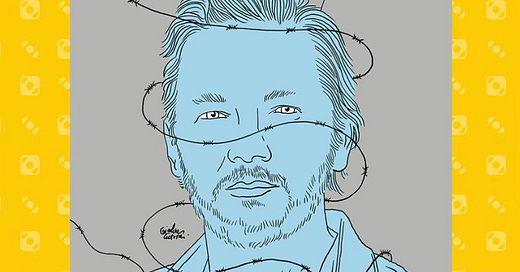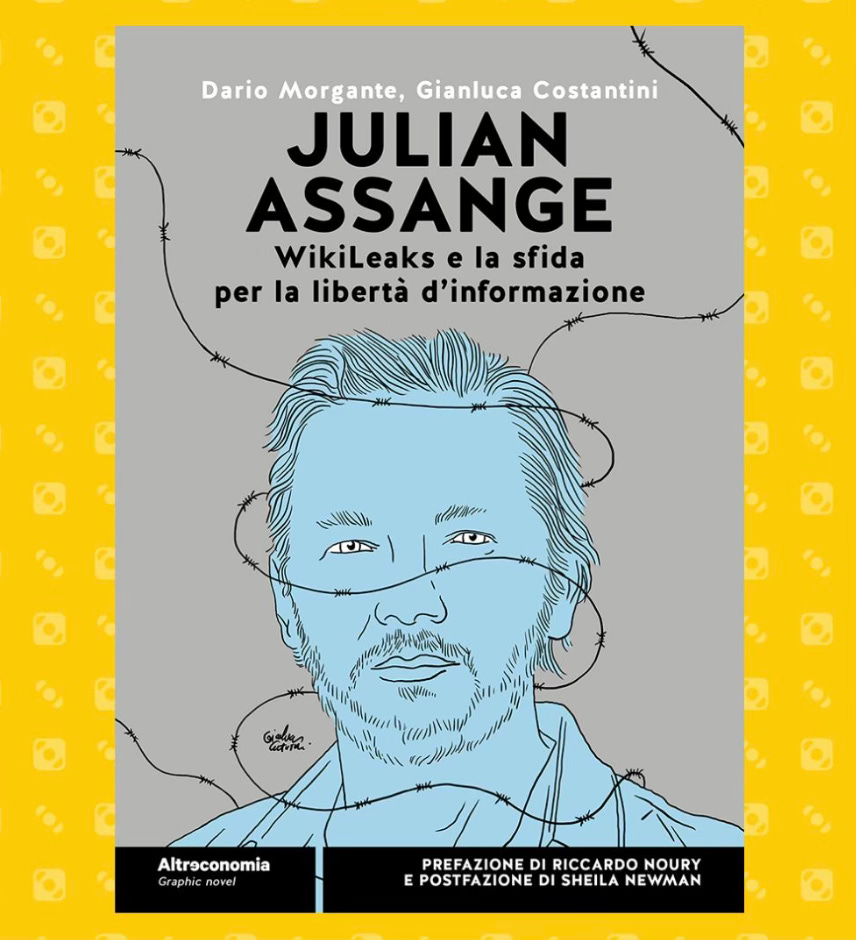👁🗨 Julian Assange, le roman graphique de Dario Morgante & Gianluca Costantini
Julian Assange n'est plus un homme libre depuis 12 ans. Sa santé mentale ne tient qu'à un fil. Sa vie sans doute aussi. Pour ses convictions & pour nos libertés, il a déjà payé un trop lourd tribut.
👁🗨 Julian Assange, le roman graphique de Dario Morgante & Gianluca Costantini
Par Luisa Nannipieri, le 16 mai 2024 - English version below
En 2011, le dessinateur Gianluca Costantini et le journaliste et écrivain Dario Morgante ont voulu écrire un roman graphique sur l'histoire de WikiLeaks et de son porte-parole, Julian Assange. À l'époque, on savait très peu de choses sur Assange et il était également très difficile de s'appuyer sur les bonnes sources pour raconter son histoire. Ils ont alors commencé à enquêter, puis à transposer en images le parcours d'un jeune Australien qui a grandi en déménageant à plusieurs reprises avec sa mère et son petit frère pendant des années, avant de devenir l'un des hackers les plus célèbres au monde et de représenter une structure capable d'ébranler les États-Unis en révélant leurs secrets au grand public.
Publié pour la première et unique fois en Italie par Becco Giallo en 2012, le livre a été choisi par Altreconomia pour inaugurer son catalogue dédié aux romans de bande dessinée et sortira quelques jours après la décision tant attendue de la Cour de justice britannique sur son extradition vers les États-Unis, prévue pour le 20 mai. Bien que plus de dix ans se soient écoulés, les auteurs n'ont pas modifié la structure du roman, qui s'achève sur la détention d'Assange à Londres à la suite de la demande d'extradition de la Suède pour une affaire d'inconduite sexuelle fin 2010. Une accusation qui s'est avérée infondée, instrumentalisée comme moyen de pression et de diversion en faveur des alliés américains. Construit selon l'un des schémas les plus classiques de la bande dessinée sérielle italienne, avec six planches de format classique, le récit présente un rythme soutenu, presque musical, et rappelle certains vieux films d'espionnage par la manière dont il ponctue le récit et fait appel aux images, en équilibrant les phases de tension et de relâchement. Bien qu'il s'agisse d'un texte dense, peut-être plus lisible et compréhensible aujourd'hui, étant donné que nous sommes plus familiers avec un monde, celui des hackers, qui en 2011 était encore peu connu, il réussit à insuffler à l'histoire une respiration couvrant différentes périodes et contextes historiques, alternant avec fluidité les années 1970 à la première décennie des années 2000.
Les seules modifications apportées à l'ouvrage, qui a déjà fait l'objet d'une édition australienne semi-clandestine, financée par des associations locales en 2021, concernent essentiellement les dialogues et les légendes, mieux adaptés, la révision de la préface et de la postface, ainsi que l'inclusion de quelques dessins récents de Costantini. L'un d'eux montre un portrait de mariage avec sa femme Stella, d’où Assange était absent, et un autre d'un enfant qui demande : “Maman, si je dis la vérité, est-ce que j'irai en prison ?”
Car ce roman graphique n'est pas tant une biographie exhaustive d'Assange qu'une histoire qui contextualise les origines et la mission de WikiLeaks, nous rappelant que l'État et le pouvoir ne peuvent tolérer que l'hypocrisie, le mensonge et les agissements sous couvert de protection de la démocratie soient révélés au grand jour. Lorsque cela se produit, ils s'attaquent à leurs adversaires en mobilisant tout leur pouvoir. Et le plus souvent, ils gagnent.
Julian Assange n'est plus un homme libre depuis 12 ans. Sa santé mentale ne tient qu'à un fil. Sa vie probablement aussi. Pour ses convictions et pour notre liberté, il a déjà payé un trop lourd tribut.
Julian Assange, the graphic novel by Dario Morgante and Gianluca Costantini
By Luisa Nannipieri, on May 16, 2024
In 2011, cartoonist Gianluca Costantini and journalist and writer Dario Morgante set out to write a graphic novel about the history of WikiLeaks and its spokesman, Julian Assange. At the time, very little was known about Assange, and it was also very difficult to draw on the right sources to tell his story. So they set about investigating, and then transposing into images, the journey of a young Australian who grew up moving house several times with his mother and younger brother over a period of years, before becoming one of the world's most famous hackers and representing a structure capable of shaking the United States by revealing its secrets to the general public.
Published for the first and only time in Italy by Becco Giallo in 2012, the book has been chosen by Altreconomia to inaugurate its catalog dedicated to comic novels and will be released a few days after the long-awaited decision of the British Court of Justice on his extradition to the USA, scheduled for May 20. Although more than ten years have passed, the authors have not altered the structure of the novel, which ends with Assange being detained in London following Sweden's extradition request for sexual misconduct in late 2010. An accusation that turned out to be unfounded, used as a means of pressure and diversion in favor of American allies. Constructed according to one of the most classic schemes of Italian serial comics, with six boards in a classic format, the story has a sustained, almost musical rhythm, and recalls certain old spy films in the way it punctuates the narrative and makes use of images, balancing phases of tension and release. Although it's a dense text, perhaps more readable and comprehensible today, given that we're more familiar with a world, that of hackers, that in 2011 was still relatively unknown, it manages to breathe life into the story covering different historical periods and contexts, fluidly alternating between the 1970s and the first decade of the 2000s.
The only changes made to the book, which had already been the subject of a semi-clandestine Australian edition funded by local associations in 2021, mainly concern the dialogues and captions, which are better adapted, the revision of the preface and afterword, and the inclusion of some recent drawings by Costantini. One of these shows a wedding portrait with his wife Stella, where Assange was not present, and another of a child asking: “Mommy, if I tell the truth, will I go to jail?”
For this graphic novel is not so much an exhaustive biography of Assange as it is a story that contextualizes the origins and mission of WikiLeaks, reminding us that the state and those in power cannot tolerate hypocrisy, lies and actions under the guise of protecting democracy being brought out into the open. When this happens, they attack their opponents with all their might. And more often than not, they win.
Julian Assange has not been a free man for 12 years. His mental health is dangling by a thread. His life probably too. For his convictions and for our freedom, he has already paid too heavy a price.
Julian Assange. By Dario Morgante and Gianluca Costantini. 160 pages in black and white. Altreconomia. 18 euros.





